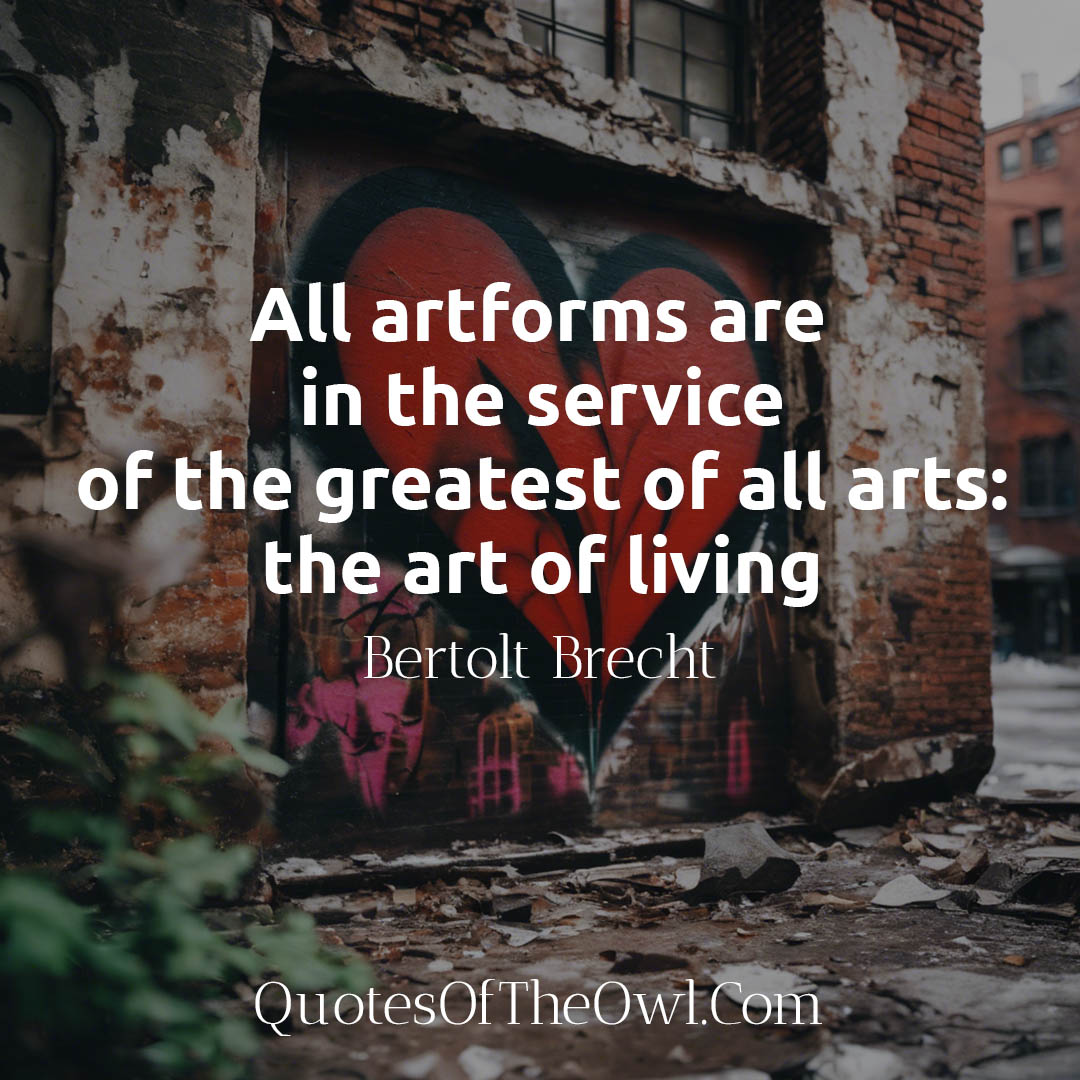All artforms are in the service of the greatest of all arts: the art of living. – Bertolt Brecht
Bertolt Brecht’s quote, “All artforms are in the service of the greatest of all arts: the art of living,” encapsulates a profound truth about the role of art in human existence. This statement suggests that all forms of artistic expression, whether it be music, literature, visual arts, or performance, ultimately aim to enhance and enrich the human experience. Understanding this quote requires delving into Brecht’s philosophy and examining how art and life are intricately intertwined.
Understanding Bertolt Brecht
Bertolt Brecht was a German playwright, poet, and theater director who left an indelible mark on the world of art and literature. Born in 1898, Brecht’s work was characterized by its critical stance on societal issues and its innovative theatrical techniques. He was a key figure in the development of epic theater, a style that encourages audience reflection rather than emotional manipulation. Brecht believed that art should serve a social purpose, aiming to educate and provoke thought, rather than merely entertain.
The Art of Living
The art of living refers to the skill and wisdom required to navigate life in a fulfilling and meaningful way. It encompasses the ability to find joy, purpose, and balance amidst the complexities of daily existence. Living is considered an art because it requires creativity, adaptability, and a deep understanding of oneself and others. Just like any other artform, mastering the art of living involves continuous learning, practice, and refinement.
All Artforms
Artforms are diverse expressions of human creativity and imagination. They include music, painting, sculpture, literature, theater, dance, culinary arts, and more. Each artform offers unique ways to explore and interpret the world, providing both creators and audiences with opportunities for reflection, connection, and transformation.
Interconnection Between Artforms and Life
Art and life are inseparable. Art influences how we perceive and interact with the world, shaping our experiences and emotions. For instance, a powerful piece of music can evoke deep feelings and memories, while a beautiful painting can inspire contemplation and appreciation of nature. Real-life examples abound: consider how the protest songs of the 1960s galvanized social movements, or how novels like George Orwell’s “1984” have shaped political discourse.
Music as an Artform
Music plays a crucial role in our lives. It can uplift our spirits, provide comfort in times of sorrow, and bring people together in celebration. Think of iconic songs like Bob Dylan’s “Blowin’ in the Wind” or Beethoven’s Ninth Symphony. These pieces transcend mere entertainment, offering profound insights into the human condition and fostering a sense of shared humanity.
Literature as an Artform
Literature has a powerful impact on how we understand ourselves and the world around us. Through stories, poems, and essays, writers explore complex themes and emotions, challenging readers to think critically and empathetically. Works like Harper Lee’s “To Kill a Mockingbird” and Gabriel Garcia Marquez’s “One Hundred Years of Solitude” illustrate the capacity of literature to address societal issues and explore the depths of human experience.
Visual Arts as an Artform
Visual arts, including painting, sculpture, and photography, have a significant influence on our perception of reality. Artists like Vincent van Gogh and Frida Kahlo have used their work to express personal struggles and triumphs, creating pieces that resonate deeply with viewers. Visual arts encourage us to see the world from different perspectives and appreciate the beauty and complexity of our surroundings.
Performing Arts as an Artform
Theater, dance, and other performing arts bring stories to life through movement and expression. They offer audiences a chance to engage with narratives in a visceral and immediate way. Icons like William Shakespeare in theater and Martha Graham in dance have pushed the boundaries of their respective artforms, demonstrating how performance can explore the intricacies of human relationships and societal dynamics.
Culinary Arts
Culinary arts elevate everyday sustenance into a form of artistic expression. Chefs like Julia Child and Ferran Adrià have transformed cooking into an artform, creating dishes that delight the senses and tell stories of culture and tradition. The act of preparing and sharing food becomes a means of connection, celebration, and cultural expression.
Craftsmanship and Design
Craftsmanship and design play a vital role in shaping our physical environment. From architecture to fashion, skilled artisans and designers create objects that are not only functional but also aesthetically pleasing. Figures like Frank Lloyd Wright in architecture and Coco Chanel in fashion have demonstrated how design can enhance the quality of life and reflect individual and cultural identities.
The Art of Communication
Effective communication is an essential aspect of the art of living. It involves the ability to convey thoughts and emotions clearly and empathetically, fostering understanding and connection. Whether through spoken words, written text, or nonverbal cues, mastering the art of communication can significantly enhance personal and professional relationships.
The Art of Relationships
Building and maintaining meaningful relationships is a crucial part of the art of living. This involves cultivating empathy, trust, and mutual respect. Relationships require continuous effort and attention, much like any other artform. Strategies for nurturing relationships include active listening, expressing appreciation, and addressing conflicts constructively.
Challenges in the Art of Living
The art of living is not without its challenges. Life presents numerous obstacles, from personal setbacks to societal pressures. However, artistic expression can serve as a powerful tool for overcoming these challenges. Engaging in creative activities can provide a sense of purpose, offer a means of emotional release, and foster resilience in the face of adversity.
Conclusion
Bertolt Brecht’s quote underscores the profound connection between art and life. All artforms, in their myriad expressions, ultimately serve to enhance the greatest of all arts: the art of living. By embracing creativity and artistic expression, we can navigate life’s complexities with greater insight, joy, and fulfillment. As we cultivate our appreciation for the arts, we enrich our own lives and the lives of those around us.

